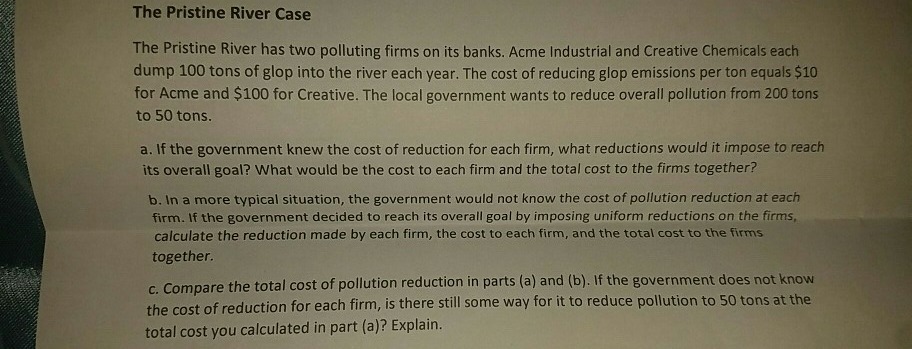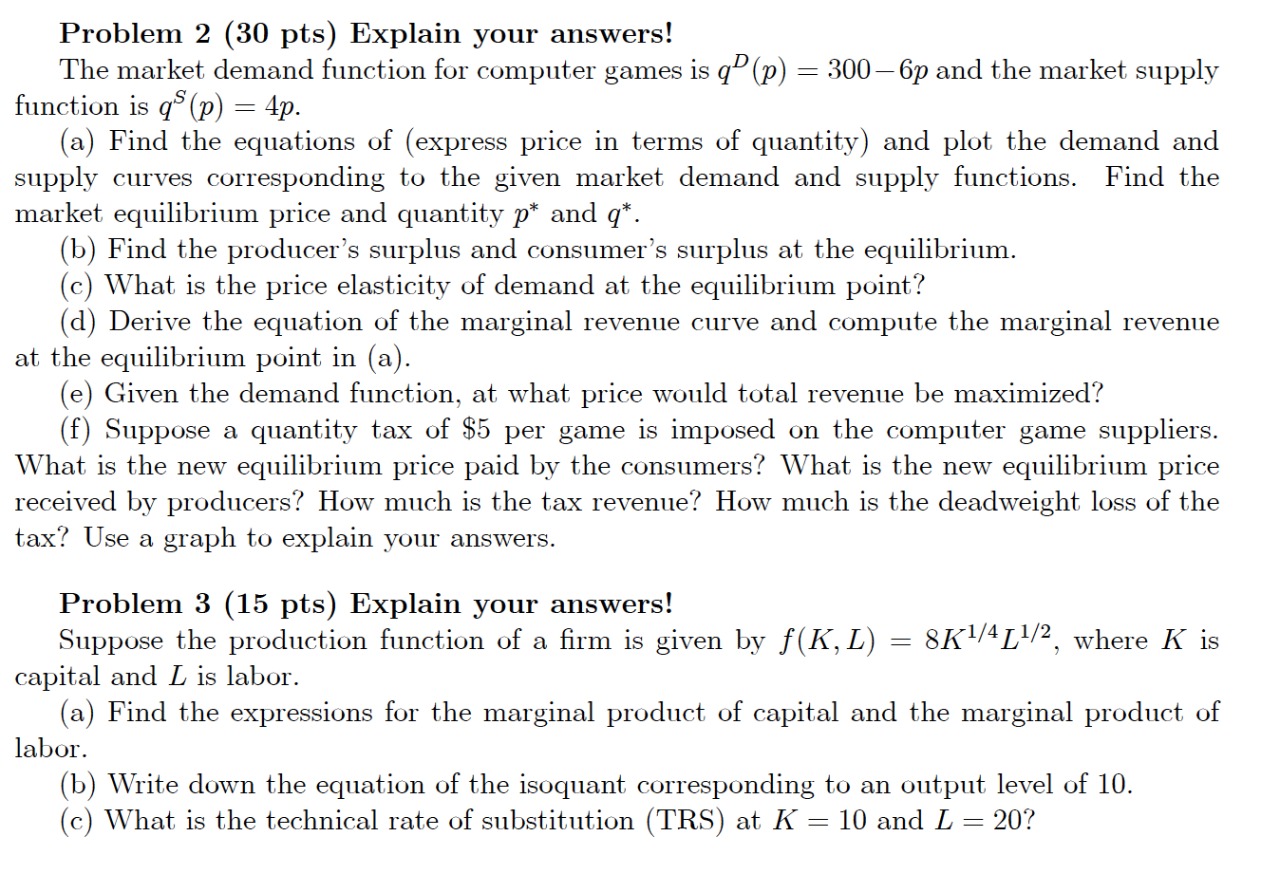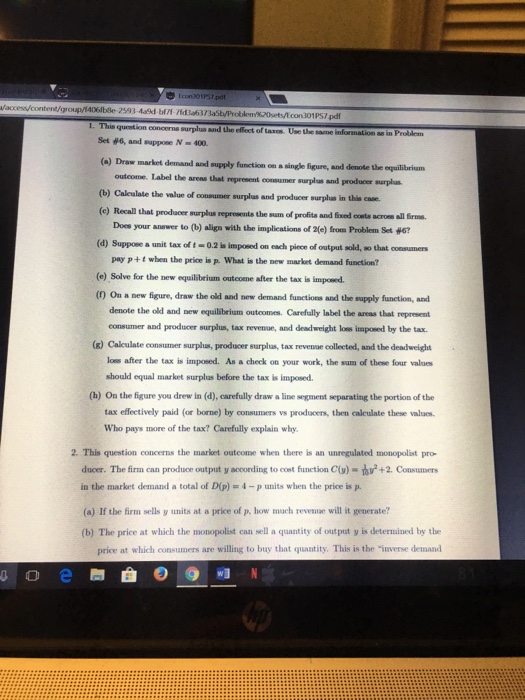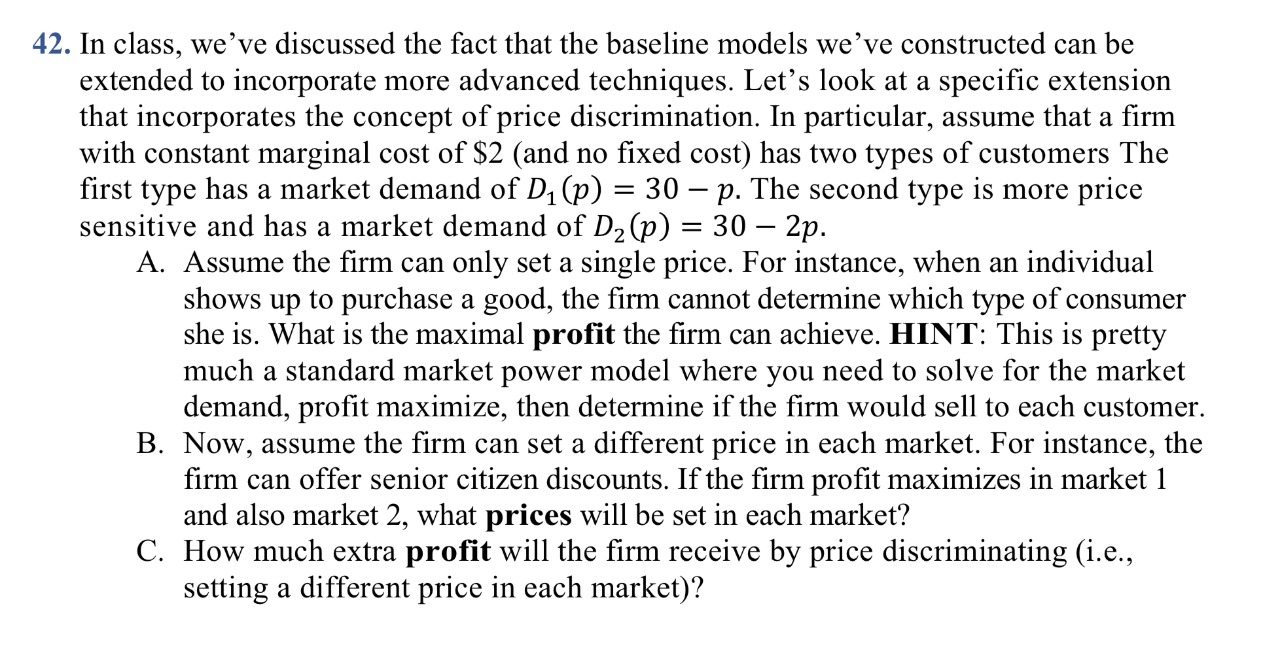Solve the following attachments
The Pristine River Case The Pristine River has two polluting firms on its banks. Acme Industrial and Creative Chemicals each dump 100 tons of glop into the river each year. The cost of reducing glop emissions per ton equals $10 for Acme and $100 for Creative. The local government wants to reduce overall pollution from 200 tons to 50 tons. a. If the government knew the cost of reduction for each firm, what reductions would it impose to reach its overall goal? What would be the cost to each firm and the total cost to the firms together? b. In a more typical situation, the government would not know the cost of pollution reduction at each firm. If the government decided to reach its overall goal by imposing uniform reductions on the firms, calculate the reduction made by each firm, the cost to each firm, and the total cost to the firms together. c. Compare the total cost of pollution reduction in parts (a) and (b). If the government does not know the cost of reduction for each firm, is there still some way for it to reduce pollution to 50 tons at the total cost you calculated in part (a)? Explain.Problem 2 (30 pts) Explain your answers! The market demand function for computer games is qD (p) = BOOSp and the market supply function is qs(p) = 4}). (a) Find the equations of (express price in terms of quantity) and plot the demand and supply curves corresponding to the given market demand and supply functions. Find the market equilibrium price and quantity p* and if". (b) Find the producer's surplus and consumer's surplus at the equilibrium. (c) What is the price elasticity of demand at the equilibrium point? ((1) Derive the equation of the marginal revenue curve and compute the marginal revenue at the equilibrium point in (a). (e) Given the demand function, at what price would total revenue be maximized? (f) Suppose a quantity tax of $5 per game is imposed on the computer game suppliers. What is the new equilibrium price paid by the consumers? What is the new equilibrium price received by producers? How much is the tax revenue? How much is the deadweight loss of the tax? Use a graph to explain your answers. Problem 3 (15 pts) Explain your answers! Suppose the production function of a rm is given by f (K ,L) = SK 1/4111\1. This quration concerns surplus and the effect of taxes. Use the sue information as in Problem Set 46, and suppose N = 400. (a) Draw market demand and supply function on a single figure, and denote the equilibrium outcome. Label the areas that represent consumer surplus and producer surplus (b) Calculate the value of consumer surplus and producer surplus in this case. (c) Recall that producer surplus represents the sum of profits and fixed costs across all firms. Does your answer to (b] align with the implications of 2(e) from Problem Set #6? (d) Suppose a unit tax of : = 0.2 is imposed on each piece of output sold, so that consumers pay p+ # when the price is p. What is the new market demand function? (e) Solve for the new equilibrium outcome after the tax is imposed. (f) On a new figure, draw the old and new demand functions and the supply function, and denote the old and new equilibrium outcomes. Carefully label the areas that represent consumer and producer surplus, tax revenue, and deadweight loss imposed by the tax. (g) Calculate consumer surplus, producer surplus, tax revenue collected, and the deadweight loss after the tax is imposed. As a check on your work, the sum of these four values should equal market surplus before the tax is Imposed. (h) On the figure you drew in (d), carefully draw a line segment separating the portion of the tax effectively paid (or borne) by consumers vs producers, then calculate these values. Who pays more of the tax? Carefully explain why 2. This question concerns the market outcome when there is an unregulated monopolist pro- ducer. The firm can produce output y according to cost function Cly) = by" +2. Consumers in the market demand a total of D(p) = 4 - p units when the price is p. (a) If the firm sells y units at a price of p. how much revenue will it generate? (b) The price at which the monopolist can sell a quantity of output y is determined by the price at which consumers are willing to buy that quantity. This is the "inverse demand e42. In class, we've discussed the fact that the baseline models we've constructed can be extended to incorporate more advanced techniques. Let's look at a specic extension that incorporates the concept of price discrimination. In particular, assume that a rm with constant marginal cost of $2 (and no xed cost) has two types of customers The rst type has a market demand of 01 (p) = 30 p. The second type is more price sensitive and has a market demand of D2 (p) = 30 2p. A. Assume the rm can only set a single price. For instance, when an individual shows up to purchase a good, the rm cannot determine which type of consumer she is. What is the maximal prot the rm can achieve. HINT: This is pretty much a standard market power model where you need to solve for the market demand, prot maximize, then determine if the rm would sell to each customer. B. Now, assume the rm can set a different price in each market. For instance, the rm can offer senior citizen discounts. If the rm prot maximizes in market 1 and also market 2, what prices will be set in each market? C. How much extra prot will the rm receive by price discriminating (i.e., setting a different price in each market)










